Introduction
This repair guide was authored by a member of the iFixit community and hasn’t been endorsed by Google. Learn more about our repair guides here.
If the device doesn't charge or won't record audio, then the microphone and charging port may need to be replaced. These components are located on the daughterboard.
Tools
-
-
Turn off the device.
-
Prepare an iOpener to heat the edges of the display and soften the adhesive underneath. Alternatively, you may use a heat gun or a hair dryer.
-
-
-
For reference, the back of the display panel is shown at left. Note the narrow clearance between the side of the display unit and the OLED panel. (The bezels indicate this spacing on the front.)
-
-
-
Use a suction handle to pull up on the display and create a slight gap between the display and the phone's chassis.
-
You may need to apply more heat if this doesn't come up. Don't be impatient, this will take time. Once you can gently insert a tool in the gap, move on to the next step.
-
-
-
Insert an opening pick or a playing card into the gap between the chassis and the display assembly.
-
Begin to slide the opening pick around the edge of the display, cutting through the adhesive that secures it.
-
-
-
With the adhesive cut, slowly lift the display up from the top (the side with the speaker-grille cutout), carefully flip it over vertically toward the bottom of the device, and rest it on its face, as shown.
-
-
-
Use a T5 Torx driver to remove the two black 3.5 mm T5 screws securing the display cable connector bracket.
-
-
-
Use tweezers to remove the bracket that holds the display connector in place.
-
This is just a piece of metal, and should come up very easily. (The cable is removed in the next step.)
-
-
-
The midframe is held tightly in place by five clips. To release these clips, apply inward pressure with an opening tool as shown in the steps below.
-
-
-
Wedge an opening pick into the notch that is located at the bottom right corner of the phone.
-
-
-
Slide the opening pick up both sides of the device in the small space between the midframe and the rear case to release the clips holding it in place.
-
-
-
Use a spudger to pry the earpiece speaker cable connector straight up, disconnecting it from the motherboard.
-
Remove the mid-frame from the device.
-
-
-
Use tweezers to lift up the silver strip at the top of the daughterboard, and peel it back to expose the connector underneath.
-
-
-
To disconnect the cable, use tweezers to carefully pull the connector away from the socket by its cables.
-
-
-
To do so, peel back the sticker on the motherboard side and use a spudger to lift the connector straight up.
-
-
-
Use a spudger to pry up the black and white coaxial cables attached to underside of the daughterboard.
-
Compare your new replacement part to the original part—you may need to transfer remaining components or remove adhesive backings from the new part before installing.
To reassemble your device, follow the above steps in reverse order.
Take your e-waste to an R2 or e-Stewards certified recycler.
Repair didn’t go as planned? Check out our Answers community for troubleshooting help.
6 comments
Hi, I’m looking to fix my google pixel, it has the common microphone problem where I can’t record any audio/ make calls on m device. Where can i purchase a replacement for the daughterboard? I really need to get it fixed. Thanks
That’s a lot of steps. I miss the days where you could just pop the back of the phone case off. :/
Phillip -
where can I look on the daughterboard if everything else seems to work except the speaker? and I don’t mean the earpiece speaker, the main speaker below. The problem appeared after I replaced the battery, so its most likely something I’ve done, I’ve retraced my steps but I don’t see any major issues.
Hey Henry! The daughterboard connects to the speaker with two golden pins that rest on the contact pads that stick out to the right of the speaker. You can see them in this photo. I would recommend cleaning the pins and the pad with some isopropyl alcohol and a q-tip. If that doesn’t fix the problem, check all the pins on both ends of the big interconnect cable and its corresponding sockets on the two boards—you may have accidentally bent one of them! If that’s the case and the bend is obvious, you can try to bend the offending pin back into place, or pick up a replacement cable. Hope this helps!
@taylord Thank you so much for pointing out those pins! You likely saved my sister’s phone. I’m fairly experienced with hardware repair but foolishly allowed one of the coax cables to run underneath the corner of the daughterboard. After cleaning the contacts and reinstalling the daughterboard the speakers and microphone are working, which is why I was trying to replace the board in the first place.
Thank you!
Adam Lee -
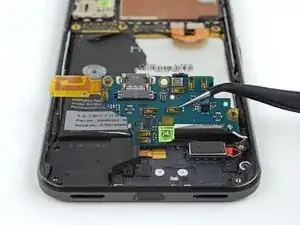
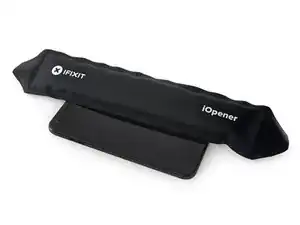
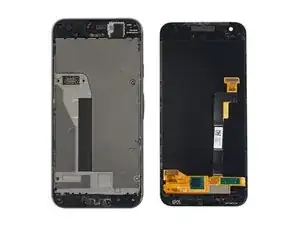

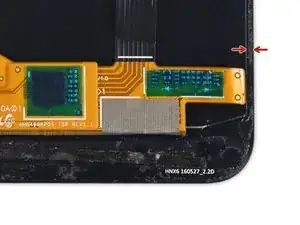
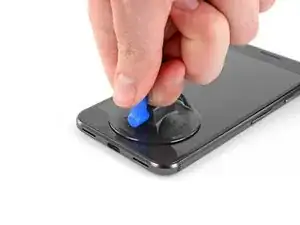
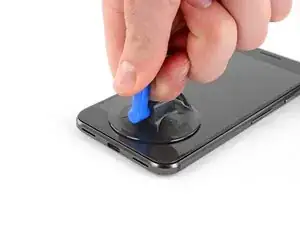
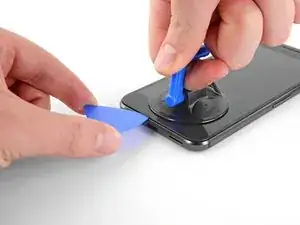
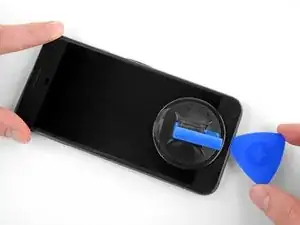
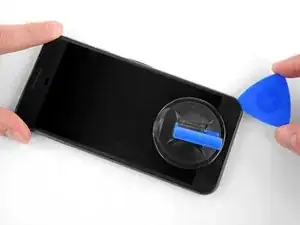
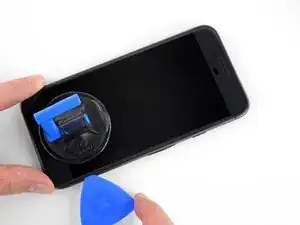
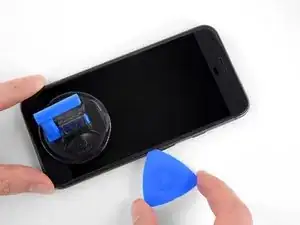


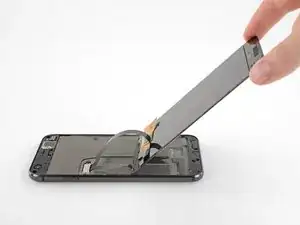
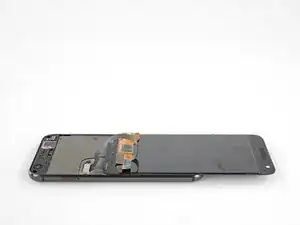

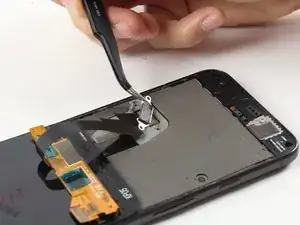
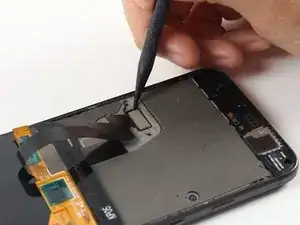


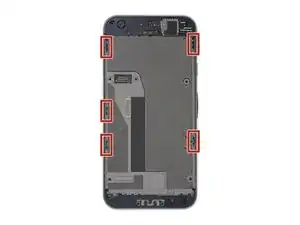

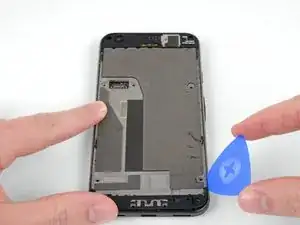
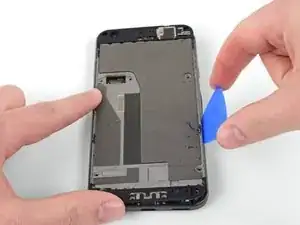
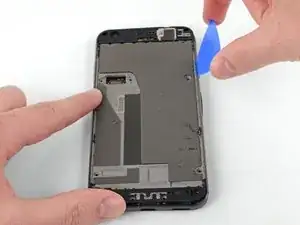

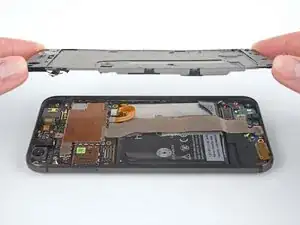






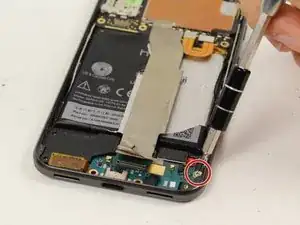






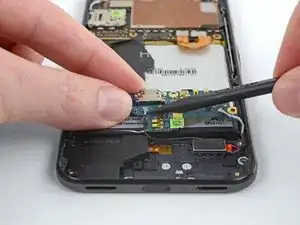




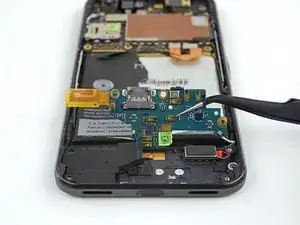

When reassembling, does the adhesive still hold the phone together when closed or do we need to apply more adhesive?
Jess Haddow -
Step 10 addresses this: there should be a plastic sheet that looks like your screen in the repair kit. This is the new adhesive for reassembly.
Peter Karski -
Unfortunately also cracked my display on the way in. You have to go pretty deep under the top and bottom of the screen but BARELY in around the sides, especially the corners. If I had to do it over again, I would have either tried a playing card or put some type of depth limit/mark on my pick so I didn’t go more than a few millimeters in.
Matthew Jastremski -
Use plenty of heat here and take your time. Start from the top, then the sides. use a gentle prying motion with the picks but don’t go too deep.
Richard Wood -
It’s EXTREMELY easy to crack the screen. Just buy a new display module before fixing it. The old screen will be disposable.
Buyi Yu -
Don’t even waste your time with the iOpener. I went straight for the hair dryer and opening picks took 30 mins to get the screen off with no issues.
eric duchene -
Hair dryer worked for me, thanks!
David Gault -
As others have said, the iOpeners didn't work for me at all. I tried microwaving, I tried boiling, but even when the iOpener was too hot to touch the phone didn't get that hot. A hair dryer eventually worked, but took a long time too, and I had to pull quite hard (similar to pulling on a really stuck LEGO brick, I was surprised my screen didn't crack). I also dripped some isopropyl along the edge where I could lift it a teeny bit but not get a pick in, which seemed to get the gap to widen. Once I had an edge up and could start sliding the pick along though everything went much more smoothly. Reading other comments, I bet a heat gun would have been a better tool.
Mark Fickett -
If you haven’t purchased this kit yet then stop right here. The difficulty, as stated, is very difficult. This was my first attempted repair. I spent a good hour heating the adhesive and felt good about getting the display off. I even paused to boot the phone to make sure I didn’t damage the screen before flipping it over - it worked fine still! Then I went to pull the display from the top using the picks. Shattered the corner of the screen. $129 for a new screen. At this point, the Pixel 3 is $499. I bought a new phone. Just be prepared to break the screen. Many people mention it in the comments. I felt confident I could do it. I couldn’t.
Michael Neil -
do yourself a favor and purchase a replacement screen when you order a battery. it’s impossible to remove the screen without damaging it no matter how careful you are.
Andrey Gerasenkov -
100% agree. So glad that I did. My new screen was only £20 from ebay - took ages to arrive as it came from China, but works perfectly.
Daniel Yeo -
I managed it - this was my first repair. It’s a lot harder than I was expecting, but totally doable! I recommend just sliding the very edge of the pick around first until you find a corner that starts to peel up. Once you can see under the screen (without bending it, of course!), you can go further in to break the stubborn adhesive globs. It took me just under 30 minutes to remove the screen.
Peter Karski -
My tip: Place a hot-water bottle on the screen for 2 minutes. Use the suction handle to lift one edge and insert an opening pick. Use an opening tool to cut through the adhesive at the bottom and place another opening pick in the second corner. Place the hot-water bottle on the phone again and wait 2 minutes. Cut through the sides with the opening tool (if you are focused it's nearly impossible to put this tool in too deep) and do the same on the top of the phone as on the bottom. I was afraid of the high difficulty, but it only took me 15 minutes to remove the screen with no problems. Medium difficulty.
Dorian -
I didn’t crack the screen, but somehow the thing wouldn’t power on after. Not sure if it was heat, or if I borked the cable somehow. New screen went in and it works great.
Chris Jones -
It IS possible to get the screen off without breaking it, just take your time. I spent about an hour using the included picks along with the iopener.
That said, the adhesive is a bear to fully remove from the screen without marring it up.
Kixwooder -
I didn’t fully remove the old glue; When I put it back together, I melted the old glue (and some new glue) to seal it all closed again.
David Gault -
Tip, use a gallon ziplock bag with some hot water (maybe 150 degrees). Place the phone on a towel and fold the towel over and shield the part you aren’t working on, then use the bag for ~30s to apply and re-apply heat as needed. I first heated up the entire phone and ended up separating the screen from the glass (thus breaking the screen). The second time I did it, I just heated up one section at a time and I succeeded in removing the screen without breaking it.
Daniel Beardsley -
Couldn’t get it open with anything, including dunking it (wrapped in a ziplock) in freshly boiled water for from 2 to 20 minutes. But then I managed to get it with only minor discolorations along top and bottom edges (which are noticeable when the screen is off or on dark backgrounds).
What did the trick was setting the heat gun to 100°C and heating it really up close for 2 minutes. 60°C didn’t do squat, but 80-90°C would probably work better, without damaging the screen.
With that done, the glass required a little bit of force to lift up, force of gravity on the rest of the phone wasn’t enough.
gelraenua -
I attempted this with an iOpener and gave up as it didn’t seem to heat it enough to lift the edge of the screen.
I remembered I had a heat gun at that point (duh, should’ve been what I started with). I had the gun at 350 initially and moved it around relatively quickly. But, discovered that if I lingered a little it discolored the screen (tested and the screen still works where it’s discolored, but it’s slightly off-color at one corner). I ended up using 200 deg (F) instead and moved more slowly. I put slight pressure on with the suction cup while heating the edges and finally got a corner up. Plopped a pick in there and used another pick to slowly cut along that edge while heating where cutting. I kept a pick plopped in each corner as I went. Once I got most of the screen free I grabbed the edges of the screen to keep upward pressure from the glue and heated any places that were still stuck with the heat gun and cut the last strands with another pick.
TL;DR - The iOpener doesn’t seem sufficient for this job.
Jonathan Stucklen -